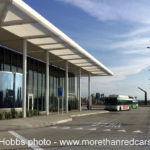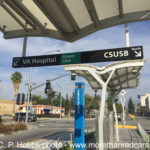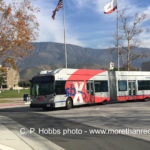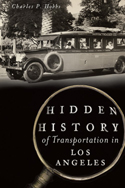During the past two years, Omnitrans has added two bus services that enable passengers to travel faster. These are the sbX bus rapid transit system, which opened in April 2014, and Line #290, a freeway express bus route that started service in September 2015. Up until now, I had not had a chance to ride either of these routes, so I decided to try them out.
On Wednesday, January 4, I started my trip at the Montclair Transcenter, which hosts not only the #290, but also several local Omnitrans routes, Foothill Transit (serving Los Angeles County) and Riverside Transit Agency’s express line #204 to Riverside.
At 8:45 AM, we left Montclair with seven other passengers. The ride on the I-10 freeway was fast and smooth. My mind went back in time to the 290’s forerunner, the Inland Empire Connection, which started service along a similar route in August 1990. Back then, the IEC bus stopped at Ontario Airport and a park-and-ride lot in Bloomington on its way to San Bernardino. This service lasted until mid-2006, when it was canceled due to low ridership.
Our first stop was the Ontario Mills shopping center, which is also a transfer point to/from Omnitrans local routes. One passenger left the bus, but was replaced by four new people. The next stop was at the Arrowhead Regional Medical Center, yet another major bus transfer point. One got off here, and two got on.
The final stop was at San Bernardino’s new downtown transit center, which Omnitrans shares with Mountain Transit (to Lake Arrowhead and Big Bear), Victor Valley Transit (north to Victorville and Barstow), and Pass Transit (east to Beaumont and Banning). No Greyhound service, though. The transit center features a small waiting room with a restroom and a counter selling bus passes. Nearby, crews were working on a platform for Metrolink commuter trains, scheduled to open in April.
The trip on #290 had taken a mere 52 minutes. If I had taken local bus service, (Omnitrans #66 and #14), it would have taken over two hours and required a transfer in Fontana.
Next on my to-do list was the sbX, the bus that thinks it’s a light rail. Buses run in reserved lanes on the street, and passengers wait at special platforms. Some sbX stations are in the center of the street, and buses feature passenger doors on both their left-hand and right-hand sides. Stations also have ticket machines accepting credit/debit cards; cash-paying passengers can board at the front door and pay at the farebox.
The sbX buses do not stop at the transit center, but on their own on-street station. This required a three-minute walk. A glance at the schedule told me I would have enough time to ride sbX to Cal State University San Bernardino and back downtown, in time for the #290 back to Montclair. (I’ll ride and report on the Loma Linda half of the route later).
The sbX bus pulled up to the station and I, along with four other people, got on board. This trip was rather lightly loaded, perhaps about twelve passengers.
Rather than ride all the way to the route’s end at Palm Avenue, which features a park-and-ride lot and not much else, I deboarded at the CSUSB station. According to the Transit App on my iPhone, I had about 15 minutes before the southbound sbX arrived. I used that time to walk around campus and take a few pictures.
The southbound trip was busier; the bus ran about half-full. Nice ride, except for one fellow eating Chinese take-out on the bus (and making the rest of us hungry!) We arrived at the Transit Center stop. I rushed across the transit center’s concrete plaza, almost sure that the #290 was about to leave. But there was the bus, with a line of twelve passengers boarding. I caught my breath, got on board, and took my seat.
As we headed back to Montclair, I thought about the improvements, both current and future, involving public transit in San Bernardino County. Along with the Metrolink service to downtown San Bernardino, spring would bring a new line #208 linking San Bernardino, Redlands, and Yucaipa. In three more years, a new rail line will serve Redlands and a new sbX bus route will connect Pomona, Ontario, and Fontana. All these services will enable passengers to travel farther–faster.





Interesting observations through your experience. Thanks for sharing it with us. Sadly seems very car culture Inland Empire. Wonder would you think it help if the bus routes served job centers more so? Or is the job center still Los Angeles?
So, Omnitrans is trying out a version of Bus rapid Transit, but it’s too early to tell if it is making a difference.